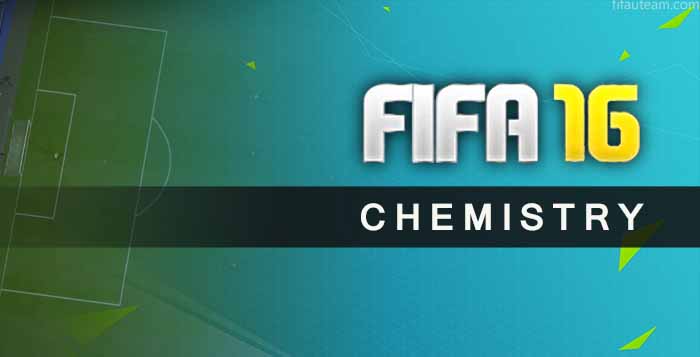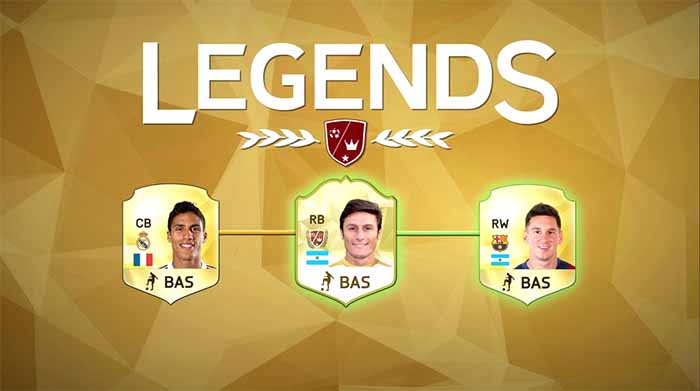Our Chemistry Guide for FIFA 16 Ultimate Team is the biggest one you will ever find. We went in a deep search and found everything there is to be discussed about this theme.
Cause chemistry is extremely important in FUT 16, be sure to read this guide.
Quick Access
- What is Chemistry ?
Basic Concepts
What Influences the Chemistry
Best Chemistry Possible
The Legends’ Chemistry
The Substitutes’ Chemistry
Chemistry Tips
Common Mistakes
What’s Wrong with Chemistry ?
New Stuff
Frequently Asked Questions
What is Chemistry in FIFA 16 Ultimate Team ?
Our skills as gamers is not the only thing important to win a match. The efficiency of our players on the pitch and of the team in general depends directly on three main factors:
- The player’s attributes;
- The Chemistry;
- The Player’s Fitness.
The Chemistry takes a fundamental role on your team’s performance, so it can never be despised. It represents how well a player will perform in-game. Low chemistry values will hinder players’ ability, whilst high chemistry values will result in players performing well.
It evaluates the health of every relation in a club. In other words, the chemistry is a factor that helps the game play by interacting with the familiarity of the player with his positioning, the relation with the other players and the manager.
In the end, that is what the chemistry does. Take all these situations, weigh how much they can benefit the performance of a team and transfer them to the four lines of this evaluation.
In general, the introduction for chemistry in FIFA 16 Ultimate Team is there to give more logic to the game and to make the building of a team more complex, challenging and diverse.
Basic Concepts of Chemistry in FIFA 16 Ultimate Team
The team should be built around chemistry and not the opposite
The first idea that has to be present is that the chemistry is extremely important for the success of any team. In previous editions, EA have announced that “a bronze team with chemistry 100 can win without great difficulties a gold team without chemistry”. That is why it has to be taken seriously when you plan to start a new team.
Another important concept, which is not always present, is that there are two kinds of chemistry: each player’s individual chemistry and the chemistry of the team. Both influence the performance of the players on the pitch.
Individual chemistry varies between 0 and 10 and team chemistry between 0 and 100. The chemistry values can be viewed on the active squad menu, just like the image below demonstrates. The team’s chemistry is always visible in the right side. The individual chemistry was changed for right under the player card and can only be displayed if you select the menu “players’ details” under the manager’s card.
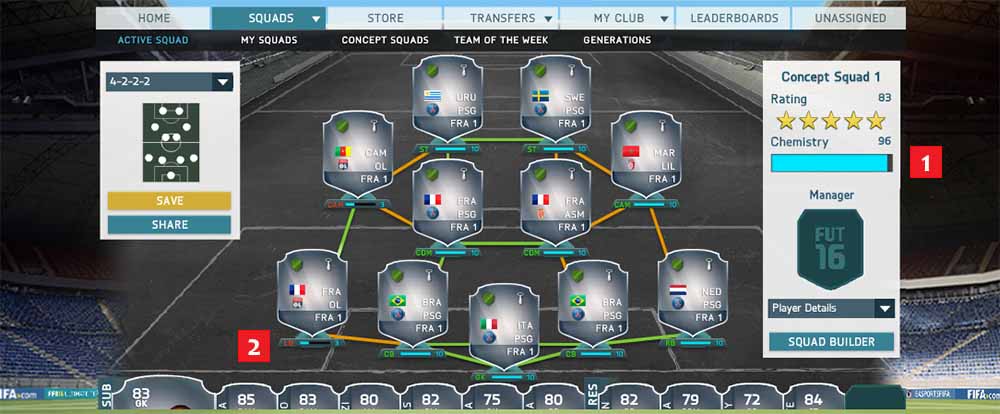
Active Squad Menu: 1- Team Chemistry; 2- Individual Chemistry
Click over the picture to maximize it
When you build a squad, individual chemistry 10 should be your goal
Any player should have as a goal building a team with the highest chemistry possible. The higher is the value, the better. The priority should be given to an individual chemistry close to or equal 10. It is also a good thing to get a team chemistry of 100.
The chemistry of the team depends exclusively of the gamer choices. It’s higher or lower depending on the players he chooses for the starting eleven, the manager he picks for the bench and the positioning of each one of the players. That way, it varies from match to match.
Now that you already know what the chemistry is, it’s time to know what it does in practice.
The chemistry interferes directly on the potential efficiency of the team during the match. More precisely, on the players’ attributes. That way, in the beginning of each match, the players’ attributes are directly affected by their individual chemistry and also by the team’s depending on the chemistry style that is active. The chemistry value that is used in game is the weighted average of the individual chemistry (75%) and the squad’s chemistry (25%).
Unlike many people think, having individual chemistry values of 10 is much more important than having a value of 100 on the squad’s chemistry display. Even because the individual chemistry doesn’t only weights three quarters of the chemistry utilized on the game, but it also affects directly the chemistry of the squad.
What influences the Chemistry and How to Improve it
The Chemistry measures several factors that are considered enough important to affect the performance of a player.
Here is what influences a player Chemistry in FIFA 16 Ultimate Team:
- His position
- His relation with team mates
- His relation with the manager
- His loyalty to the club
If he is playing in his natural position
If the players next to him have the same nationality or play in the same league or club as him
If his manager is from the same league or nationality
If he played more than 10 matches or if it is his first club
Player Position
Players are used to play on a determined position but they can adapt themselves to similar positions. That is also what happens in FUT 16.
According to his positioning, a player may be in one of the following situations:
- Playing in his natural position
- Playing in a position that is very similar to his natural position
- Playing in a position that has some similarities to the natural position
- Playing in a position that is very different from the natural position
The position health is found directly underneath the player card: green means that he is playing on his natural position, orange means that he is playing in an adapted position and red means that he is playing on a position that is very different from the natural position.
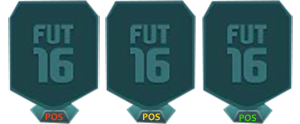
The natural position of a player is shown on his card. The position where he’s about to play is shown on the active squad menu. The first situation refers to when both positions are the same. That is the greatest situation to benefits the chemistry.
When a player is assigned to play in a strange position for himself, the chemistry is strongly affected. The goalkeepers is a good example of that. They can only play well on the goal, and are the only players that can’t get adapted to another position.
When a player’s preferred position doesn’t match with the position he’s about to play, it’s possible to fix this applying a position modifier card. These cards can only be applied with success if they indicate the current preferred position of the player and the one he will play. You can learn more about it here (available soon).
In order to know what positions a player can get adapted to, consult the folowing table:
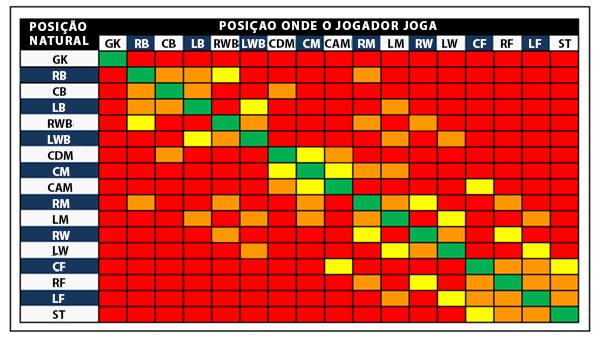
Green – natural position | Yellow – very similar
Orange – some similarities | Red – very different
Relation with the other Players
The more two players have in common, the higher will be the chemistry and better they will play.
Chemistry links are connections between players in a team. When two players are placed next to each other, they form a connection. This connection is represented by a coloured link, according to the intensity of the relation, and can be classified in:
- Dead Link
If the connection is between two players with different nationalities, different clubs and different leagues (Messi and Ibrahimovic, for example); - Weak
If the connection is between two players with the same nationality and different leagues OR if they are from the same league but different clubs (James Rodriguez and Falcão, for example); - Strong
If the connection is between two players with the same nationality and league but different clubs OR if it’s between two players from the same club (Pique and Sergio Ramos, for example); - Hyper
If the connection is between two players with the same nationality and club (Ronaldo and Pepe, for example).

Coloured links: green for hyper and strong, orange for weak and red for dead link.
The dead links are the weakest connections and consequently the most penalising for the chemistry.The hyper ones are the strongest and the most rewarding connections for the chemistry.
Independently of the team formation, a player must be linked to 2, 3, 4, 5, 6 or 7 team mates. The stronger these connections are, the higher will be the player’s individual chemistry.
That’s why most FUT 16 teams are built based in a league or in a nationality. This way it’s possible to eliminate the dead links and guarantee a high chemistry.
The relations between players can also possible to improved, but in order to do that, it’s necessary to adjust the team. Before buying players for the team, gamers should verify the connections intensity they will get. If they are sufficiently weak at a point that they can affect the chemistry, they should find players that can be well combined according to their nationality, league or club.
Any player plays the same way among all his team mates independently that he has different coloured connections
The intensity of the connection between two players is merely a graphic representation. It doesn’t mean that these players, in particular, play well with each other if their connection is green. What really counts for the individual chemistry is the summation of the intensities of the connections that a specific player has. Each player’s attributes are affected and not necessarily his relation with the team mates.
Relation with the Manager
To boost contracts is not the only manager’s role. To each player, he may give an extra chemistry point.
There are two manager’s characteristics that will vary the chemistry of a player:
- His nationality
- His league
The managers don’t influence the team’s chemistry directly. They do it to the individual chemistry
A manager that can be well comprehended has more success probabilities than one with worse relationships with the players. That’s why the chemistry is improved if the manager’s nationality or/and the manager’s league is the same as most players’.
The nationalities and the leagues of the players and managers are shown on the front of their cards.
To get the manager bonus, players should try to match the manager nationality or the manager league with the higher number of players from the start eleven. Pay attention that it may not be always true. For example: if all the players except one are from one specific league and already have individual chemistry 10, it may be better to try to match the manager league with the league of the only player that doesn’t have the higher chemistry possible.
When a manager league’s doesn’t match with the player’s league, it’s possible to fix this applying a league modifier card. You can learn more about it here (available soon).
Manager bonuses are represented by icons on the player card. A green icon means the player is receiving a bonus because he has, at least, the same nationality or the same league of the manager.
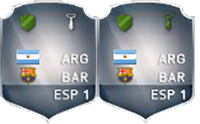
Loyalty with the Club
Loyalty was designed to further reward UT players for opening packs or keeping a player for an extended amount of games. After 10 matches of playing with the same player, or using a player pulled from a pack, the player will receive a bonus to his Individual Chemistry. He only needs one of these two things to get the bonus.
It is very easy to get this bonus. Even if it is unusual to buy packs, the player just need to play 10 matches with that card to get the bonus.
Loyalty bonuses are represented by icons on the player card. A green icon means the player is receiving a bonus because he played ten or more matches in this club or because it is his first club (or both).
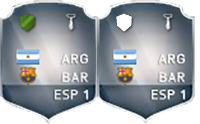
Best Chemistry Possible
A question that players usually ask to us is how to get the best chemistry possible. Here are the minimum requirements:
- Players in the right position and with the manager’s bonus or loyalty bonus
The sum of the numerical value of links should be equal or higher than the number of links
- Players in the right position without bonus
The sum of the numerical value of links should be 1.6 times higher than the number of links
- Players in a related position and with the manager’s bonus or loyalty bonus
The sum of the numerical value of links should be 1.6 times higher than the number of links
- Players in a related position and with both manager’s bonus and loyalty bonus
The sum of the numerical value of links should be equal or higher than the number of links
One of the most common questions is about the maximum chemistry that a player might get when playing out of his natural position. The answer is given in the table below. These values not include the manager’s bonus and loyalty bonus, so can still be added two more points.
| NATURAL POSITION | POSITION WHERE THE PLAYER PLAYS | ||||||||||||||||||
| GK | RB | CB | LB | RWB | LWB | CDM | CM | CAM | RM | LM | RW | LW | CF | RF | LF | ST | |||
| GK | 10 | 2 | 2 | 2 | 2 | 2 | 2 | 2 | 2 | 2 | 2 | 2 | 2 | 2 | 2 | 2 | 2 | ||
| RB | 2 | 10 | 5 | 5 | 9 | 2 | 2 | 2 | 2 | 5 | 2 | 2 | 2 | 2 | 2 | 2 | 2 | ||
| CB | 2 | 5 | 10 | 5 | 2 | 2 | 5 | 2 | 2 | 2 | 2 | 2 | 2 | 2 | 2 | 2 | 2 | ||
| LB | 2 | 5 | 5 | 10 | 2 | 9 | 2 | 2 | 2 | 2 | 5 | 2 | 2 | 2 | 2 | 2 | 2 | ||
| RWB | 2 | 9 | 2 | 2 | 10 | 5 | 2 | 2 | 2 | 5 | 2 | 5 | 2 | 2 | 2 | 2 | 2 | ||
| LWB | 2 | 2 | 2 | 9 | 5 | 10 | 2 | 2 | 2 | 2 | 5 | 2 | 5 | 2 | 2 | 2 | 2 | ||
| CDM | 2 | 2 | 5 | 2 | 2 | 2 | 10 | 9 | 5 | 2 | 2 | 2 | 2 | 2 | 2 | 2 | 2 | ||
| CM | 2 | 2 | 2 | 2 | 2 | 2 | 9 | 10 | 9 | 5 | 5 | 2 | 2 | 2 | 2 | 2 | 2 | ||
| CAM | 2 | 2 | 2 | 2 | 2 | 2 | 5 | 9 | 10 | 2 | 2 | 2 | 2 | 9 | 2 | 2 | 2 | ||
| RM | 2 | 5 | 2 | 2 | 5 | 2 | 2 | 5 | 2 | 10 | 5 | 9 | 2 | 2 | 5 | 2 | 2 | ||
| LM | 2 | 2 | 2 | 5 | 2 | 5 | 2 | 5 | 2 | 5 | 10 | 2 | 9 | 2 | 2 | 5 | 2 | ||
| RW | 2 | 2 | 2 | 2 | 5 | 2 | 2 | 2 | 2 | 9 | 2 | 10 | 5 | 2 | 9 | 2 | 2 | ||
| LW | 2 | 2 | 2 | 2 | 2 | 5 | 2 | 2 | 2 | 2 | 9 | 5 | 10 | 2 | 2 | 9 | 2 | ||
| CF | 2 | 2 | 2 | 2 | 2 | 2 | 2 | 2 | 9 | 2 | 2 | 2 | 2 | 10 | 5 | 5 | 9 | ||
| RF | 2 | 2 | 2 | 2 | 2 | 2 | 2 | 2 | 2 | 5 | 2 | 9 | 2 | 5 | 10 | 5 | 5 | ||
| LF | 2 | 2 | 2 | 2 | 2 | 2 | 2 | 2 | 2 | 2 | 5 | 2 | 9 | 5 | 5 | 10 | 5 | ||
| ST | 2 | 2 | 2 | 2 | 2 | 2 | 2 | 2 | 2 | 2 | 2 | 2 | 2 | 9 | 5 | 5 | 10 | ||
Legends’ Chemistry
Legends also need good chemistry to play better. Since they don’t have a league or club associated, there are slightly differences on how to calculated their chemistry. Basically, they link well with other Legends just like regular players link with their team mates. It’s like being a legend was a club.
In FIFA 16 Ultimate Team, the way how legends connects with other players has changed, to avoid penalize teams with legends:
- Hyper Link (Green)
Legend of the Same Nationality
- Strong Link (Green)
Legend but different Nationality
Not Legend but same Nationality
- Weak Link (Orange)
Not a Legend and different Nationality
- Dead Link (Red)
Legends don’t have dead links no matter the player they are linking.
Manager bonus and loyalty bonus work with Legends just like for any other player. There is a Manager League card ‘Legends’ that can be used to give the extra point of chemistry to your Legends. In certain cases, it may be useful to reach the maximum chemistry.
The Substitutes’ Chemistry
The substitutes are not considered in the chemistry calculation. And much less the reserves.
The team’s chemistry counts only the summation of the starting eleven’s individual chemistries. Besides that, being on the bench, the substitutes don’t participate in the relations between the players. This means that the substitutes don’t have individual chemistry and that their contribution for the squad’s chemistry is merely null.
Until now we have judged that this is very easy to understand. Although, very pertinent questions arises: if we make a substitution, what will be the chemistry of the player who goes in and how is it going to affect the team’s chemistry? And what about if we change the formation during a match?
Our tests were inconclusive on this matter but we believe that when we make a substitution, the player who goes in acquires the chemistry of the player who goes out and this way the team’s chemistry remains the same. The decisive moment for the chemistry definition should be the starting eleven set up. This means that, once the match has started, the chemistry values never change no matter what.
This should be valid for all cases. Even if we put in a player that doesn’t have any relation with the others or if he’s put to play in a completely different position.
For some people this could be seen as an opportunity. It would becomes possible to use that player we always wanted but could not use because he didn’t fit in our squad at all. We could also adapt players to other positions that usually don’t have quality choices.
Although, everything has a cost. In this case, contracts would be spent. Besides that we’ would have to interrupt the match, preferably in the beginning, to make these substitutions, which would be quite boring.
With formations, things seems to be different. It is clear enough that you can change it in-game as many times you want. It will not affect chemistry.
Note
The Substitutes’ Chemistry was not official confirmed.
Some sources says that the chemistry of a substitute is 1/11 of the Team’s Chemistry,
which will be slightly different from what we explain above.
Chemistry Tips
If you’ve read what we wrote in this article, then you already know what to do to build a team with good chemistry.
For those who still feel a little disorientated, we will give a few tips about how to build a team with good chemistry in FIFA 16 Ultimate Team.
In the first place, it’s convenient for us to define what is this “good chemistry” thing. For us, a team with a very good chemistry is one that has all individual chemistries of 10. It’s obvious that it’s not always possible to build our dream team full of individual chemistries of 10 but we should try to make them never lower than 7.
Avoid to use players with individual chemistries lower than 7
Unless you’re already an expert on this, the first step is to define what the players will have in common. We need them to have at least weak connections, since the most normal is for us to be based in a nationality or in a league to build our team. A team that has all the players from the same league or from the same nationality, will have a very good chemistry, since the players are in their natural positions. According to our table, all of them will get, at least, individual chemistry of 9. It will be enough to have a manager of that league or nationality to get the higher chemistry possible.
We shouldn’t forget to save coins to invest on the chemistry. As it was already said, the players’ positioning may be corrected in most of the times if we have a budget for that. Having all players playing in their natural positions represents half way gone.
One of the tricks for being able to build this team is knowing how to plan it before we start. Just having a general idea is not quite enough because we can start buying players and realize at the end that we don’t have enough connections. So, if we already chose what our players will have in common, it’s time to visualize what we intend to do for our team. To draw a scratch or to use a squad builder kind of application, seems to be a good move.
If you already built a team with good connections between players and with players in their natural positions, you already made the most difficult part. The easiest chemistry points are given by the active manager and by the loyalty. Ensure that the nationality and the league of the manager are well represented among the players with lower chemistry and, if you are not using players who you got in packs, try to reaches ten games as soon as possible to benefit from the two extra points.
If you did everything we said here then we guarantee you that the chemistry of your team will be the maximum possible.
If your plan is to build a hybrid squad with high chemistry, take a look to our special techniques here.
Common Chemistry Mistakes
There are three basic kinds of errors on the construction of a team with good chemistry in FIFA 16 Ultimate Team:
- The players underrate the importance of the chemistry
- The players overrate the chemistry
- The players don’’t give the chemistry its correct balance
- Legends’ chemistry changes
- Removed many links:
CM to CBR and CBL IN 3-4-1-2, 3-4-2-1, 3-4-3, 5-2-1-2 and 5-2-2-1;
CMC to CBR and CBL in 5-3-2;
CM to CB in 4-1-2-1-2 (2), 4-3-3 (3) and 4-3-3 (5);
CM to RM and LM in 4-5-1;
CMC to CB in 4-3-2-1;
RM and LM to CB in 4-1-2-1-2;
CAM to CB in 4-2-3-1 (2);
CAM to CMR and CML in 4-3-1-2;
CMR and CML to CB in 4-3-3 - Now each in-game stat receives an upgrade
- The way how team’s chemistry is calculated has changed
- It is not required a manager to reaches team’s chemistry of 100
- The way how team’s chemistry is calculated has changed
- The numerical value of a link has changed
- Two players with same nationality have now the same chemistry weight as two players with the same league
- The maximum individual chemistry possible is now 10, an not 9 as in previous years
- Managers increase the Individual Chemistry. Team’s Chemistry is not directly increased by them as in the past
- It doesn’t matter to the chemistry if the manager is gold, silver or bronze
- The Formation of the manager no longer has weight in chemistry (it doesn’t exist any more)
- The league of the manager is now important to individual chemistry
- Players with more games now receive loyalty bonus.
- Cards on the hands of original owners are worth more in chemistry
- Several changes in the relation between natural positions and position where players play
- A few formations have now more connections
- Formations no longer have weight in chemistry
- The stats that are boosted by chemistry are now decided by the chemistry styles cards
In the first situation, some players seem not to know the effect of the chemistry on the game or simply judge that it’s nothing but a myth. They’d rather build a team with the players they like independently for the chemistry. What they don’t know is that their development can be superior if they slightly modify the team substituting a few players. There’s no need to give up on all their preferences.
Unless they are just starting FUT 16, those players can be easily identified for showing up with a chemistry that is lower than 60 (it’s not possible to see the opponent’s individual chemistry).
There are also those who put the chemistry ahead of everything. Extremisms are not necessary. If you follow all of our basic tips (see on next chapter), you can be in this group. In fact, everyone who has all the starting eleven with an individual chemistry of 10 and the team’s chemistry of 100 can be in this situation.
FUT 16 allows players to reach maximum chemistry in a bunch of ways. If we apply all these methods to reach a chemistry above the maximum value, we are certainly overrating this concept. The problem about this is that we can prejudice the quality or diversity of our team without taking any advantage of it. That’s why it’s important to know how the chemistry works in FIFA 16 Ultimate Team. With this knowledge we can build teams that have only what’s really necessary to reach maximum chemistry. The teams that are made up of exclusively players from the same league, club or nationality are almost always typical cases of “chemistry waste”.
The third group is probably the most common one: the ones who commit errors when building a team because of the lack of knowledge about how to do it. This happens because many times most sources of information are not clear enough or even incorrect about what they say of this theme. It’s a common sense between FUT gamers that having a good chemistry is having a chemistry of 100. Wrong. We can have a team chemistry of 100 in which one player have an individual chemistry of zero. This is not really a desired chemistry.
The idea that circulates is that the chemistry of the team is the main thing and the individual chemistry, that many don’t know about, has little importance. This is severely false. The individual chemistry is actually the one that weighs more on the attributes set up during the matches.
These players usually have team chemistries of 100 but unbalanced individual chemistries. Some with 10 and others less than 8.
There are also some players that consider chemistry styles more important than the chemistry. That is false. One player without chemistry doesn’t need a chemistry style. Learn more about this in the chemistry styles chapter.
What’s Wrong with Chemistry ?
We are completely independent and this is great for us to be able to compliment or criticize what we think is good or bad.
In a general way we think that EA makes a very good job. It is true that there are server problems, items that get stuck on the trade pile, constant updates, etc… But when it comes to rules, FUT was a well made and implemented game. The chemistry system is a good example of that. It works and it has results.
But not everything makes sense on the chemistry of FIFA 16 Ultimate Team. We do not get why EA makes it so much secrecy. Most part of the information we published in this article was based on intensive tests we made. It is not available for the common player that doesn’t want to spend days trying to learn how the chemistry works.
The best example of what we are saying is the way how the links and the player’s positions are assigned according to the colours that indicate intensity. The hyper and strong connections are both green-coloured which doesn’t allow the distinction between each one. Also the player’s position status is indicated by only one colour, orange, which doesn’t allow the distinction between those that a player will be able to get adapted to. It would be enough just to introduce one more colour. We can only think that this was done intentionally so they could keep the chemistry secrets away from the players.
Our chemistry analyse does not end with EA. The players also make part of the game. There is a considerable number of people who insist that there is no such thing as the chemistry in the game. It is not true.
The best way for us to be certified about the influence of the chemistry on the game is playing several matches, ideally in the same condition, commanding a team with a high chemistry and another with a very low chemistry. We did this dozens of times and concluded that the chemistry in FIFA 16 Ultimate Team is actually real. Mathematically analysing the results we obtained, we concluded that when we played with a higher chemistry our performance was very superior.
Many of the people who say there’s no such thing justify themselves with the fact that they have won several tournaments playing with teams with a very low chemistry. That’s not a justification. There are FIFA gamers that are good enough to win even with inferior teams, and so with low chemistries.
There are also the ones who consider that the chemistry should be abolished from FUT 16. We respect their opinion but consider that these people don’t comprehend how FUT works at all. Part of the fun of this game mode is the opportunity for us to create a team we can get identified with. If there was no chemistry, the challenge of building a team would be smaller and the diversity of teams would be reduced.
With this article we hope we were able to clarify everything about how the Chemistry works in FUT 16 and also unmasked myths and false ideas that circulate all over the FIFA players community.
New Stuff
For experienced Ultimate Team gamers, most of what we have published here isn’t new. In that way, we have created this short chapter to show what has changed with chemistry:
FUT 15 >> FUT 16
FUT 14 >> FUT 15
FUT 13 >> FUT 14
The Chemistry in FUT 16 – Frequently Asked Questions (FAQ)
Q: What is Chemistry ?
A: Chemistry represents how well a player will perform in-game. You can learn more about it here.
Q: Does the Chemistry really exist or is it just a myth ?
A: The Chemistry really exists. You can learn more about it here.
Q: Is it worth building a team with a high Chemistry ?
A: Yes. A high chemistry means a better performance for your players.
Q: What affects the Chemistry of a player ?
A: His position, his relation with the team mates and with the manager and his loyalty to the club.
Q: How to get the loyalty bonus ?
A: Use a card that you got in a pack or play with the same player 10 matches.
Q: Which one is more important: individual chemistry or team’s chemistry ?
A: Individual chemistry.
Q: What is the maximum chemistry possible ?
A: 10 to individual chemistry and 100 to team chemistry.
Q: Do I need a manager to reach the maximum chemistry possible ?
A: No, but it helps. Manager doesn’t improve the team’s chemistry directly. He may give one point to individual chemistry. But in same cases it is possible to get individual chemistry 10 even without bonuses.
Q: Is there a difference between gold, silver and bronze managers ?
A: In terms of chemistry no.
Q: Do Managers directly add any bonus to the Team Chemistry ?
A: No. Managers increase the Individual Chemistry, which will in turn increase the Team Chemistry.
Q: I can not get maximum chemistry. What’s the minimum you recommend for me ?
A: If for some reason you can’t get the maximum chemistry, you should try at least having 8 points of individual chemistry and 90 for the team’s chemistry.
Q: I already have a squad with a chemistry of 100. That’s all that matters, right ?
A: No. The players’ attributes in-game are modified by a component in which these 100 weigh 25% and the individual chemistry weighs 75%. Because of that, more than guaranteeing the 100 points for the team’s chemistry, it’s important to get the best individual chemistry (10) for the maximum number of players possible.
Q: Can a player’s individual chemistry be superior to 10 ?
A: In theory, yes. Mathematically the individual chemistry varies between 0 and 12. It gives new ways to gamers reach the maximum chemistry. In practice, a chemistry value higher than 10 has the same effect as a chemistry value of 10.
Q: Which one is better: a player with an high individual chemistry on a low chemistry team or a player with low individual chemistry on a high chemistry team ?
A: To that player, the best is the first option. However, if the team has low chemistry it may suggest that the other players have low chemistry too and that is not good. If you want to know which is the chemistry in-game for each player, use this equation: Chemistry = (Individual Chemistry x 0.75) + (Team Chemistry x 0.025)).
Q: Does a player that has bad connections with some team mates and good connections with others play differently with them ?
A: No. The red connections are merely graphic indications. The way each player plays depends exclusively on his individual chemistry and the team’s chemistry. He’ll play the same way with everyone.
Q: What is a Chemistry Style ?
A: The chemistry styles allow players to choose which stats will be affected by chemistry.
Q: What the white and green arrows mean ?
A: A white arrow indicates a possible boost that isn’t being received. A green arrow indicates that the stat will be boosted. The more green arrows per stat, the bigger will be the boost.
Q: What happens if I don’t get the maximum chemistry ?
A: With higher chemistry the boosts will be higher. If you have low chemistries, your stats will get lower bonuses. Check our table here.
